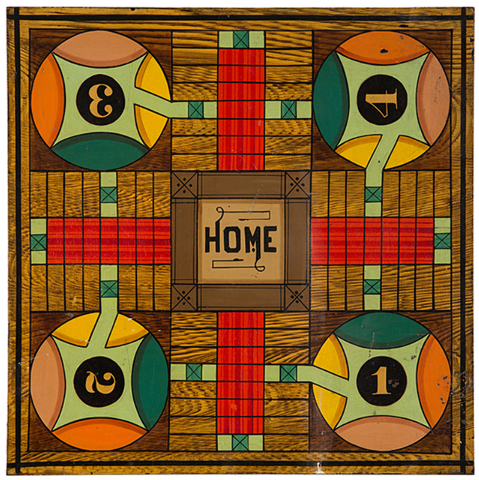Homemade game boards can sell for thousands of dollars
Not all game boards are for checkers or chess. Our ancestors played Parcheesi, backgammon and cribbage on boards that could be made at home.
From about 1850 to 1920, homemade game boards were created by talented folk artists. Elaborate designs that included the required spaces and lines for the game were carefully drawn and colored.
Many game boards were two-sided, most with a checkerboard on one side and a Parcheesi or backgammon board on the other. The majority of the boards were made of wood, although some were painted on leftover sheets of metal.
When the 1950s Early American look and the 1960s American Country look were at the height of their popularity, game boards sold quickly to be used as wall hangings. The decorating magazines featured groups of boards hanging in a hall or over a sofa, and prices went up.
A board in excellent condition with original paint can sell today for hundreds to thousands of dollars. An unusual metal game board for Parcheesi and checkers sold at a Cowan auction in April for $3,900.
Q: I bought a used wrought-iron dining set in the late ’60s or early ’70s. It includes a round table with a glass top and four matching chairs. I was told it was made by Woodard. How can I find out if that’s true?
A: Members of the Woodard family went into business in Owosso, Mich., in 1866. They began making furniture in 1868. Various members of the family operated the business until 1969, when it was sold.
The company is still in business and makes wrought-iron, aluminum and wicker furniture for casual and outdoor use. Sometimes furniture can be dated by the trademark, style or material. Woodard began making wrought-iron furniture in the 1930s. Furniture made before 1942 sometimes has brass or copper decoration.
Woodard furniture made before the 1970s is labeled with a metal plate. Furniture made after that time was labeled with a sticker. If your set was made by Woodard and doesn’t have a metal label, it was made in the 1970s.
Q: I have a small collection of railroad memorabilia. I want to sell, but I’m having a problem finding collectors. How can I find them?
A: Railroad memorabilia is known by collectors as “railroadiana.” Some collectors specialize in collecting items from a favored railroad, while others specialize in railroad china, badges, lanterns, locks and keys, timetables or other items. The Railroad Collectors Association website, RailroadCollectors.org, lists railroad hobby shows. If you go to one in your area, you will find collectors and dealers there interested in buying memorabilia.
Q: In the 1960s, I was shopping at a Buffalo, N.Y., antique shop and bought a funny Laurel and Hardy collectible. The comic figures are seated on a wood and metal bench that can rock back and forth. The figures’ arms and legs move, too. The whole display is about 2 feet high by 22 inches wide. What is it worth?
A: We were surprised to discover that there are a few different versions of “Laurel and Hardy on a Bench.” Stan Laurel (1890-1965) and Oliver Hardy (1892-1957) made more than 100 movies together from 1927 to 1950. They continued to be popular through the ’50s and even into the ’60s because their movies frequently ran on television. Most versions of your display sell for $50 to $100.
Q: When I was a boy (I’m 66 now), my father showed us what he said were a pair of sperm whale’s teeth he brought home when he was discharged from the U.S. Navy after World War II. When we were going through his things after my mother died, we found the whale’s teeth. They’re tanner than we remember and were never polished, but they’re in excellent condition. Each is about 5½ inches long. What are they worth?
A: The sale of sperm whale’s teeth, raw or scrimshawed, has been restricted since 1972. It’s considered a type of ivory. You can sell it in your own state if your state allows the sale and if you provide a notarized statement saying the teeth have been in this country and in your possession since 1972. A closely matched pair of unworked and unpolished whale’s teeth can sell for $200 to $400.
Note: Earlier this year, we answered a question from a reader who owned two original Peanuts comic strips drawn by cartoonist Charles Schulz. We told the reader the strips were valuable. We recently were contacted by a curator at the Charles M. Schulz Museum in Santa Rosa, Calif. Staff there would like to talk to any of our readers who believe they own an original Peanuts strip.The museum has a large collection of Schulz’s original strips. The museum’s website is SchulzMuseum.org.
Tip: If your glass chandelier is dirty, don’t use a spray cleaner on it. Put on white cotton gloves and dampen one with Windex. Then wipe the glass parts first with the damp glove, then with the dry glove. Swiffer sheets are also good for cleaning and dusting. Be careful if you’re standing on a high ladder.
Terry and Kim Kovel’s column is syndicated by King Features. Write to: Kovels, (Las Vegas Review-Journal), King Features Syndicate, 300 W. 57th St., New York, NY 10019.

















